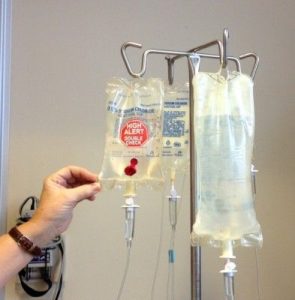Hyperthermia as an effective extension of cancer therapy
Hyperthermia as an effective extension of cancer therapy
Hyperthermia (HT), the overheating of tumor cells, is an effective extension of cancer therapy and was scientifically described almost 100 years ago. The treatment results of chemo- and radiotherapies can be significantly increased. This can lead to long-lasting remissions and contribute to healing.
Increasingly, hyperthermia is used not only in many private clinics, but also in tumor centers and hospitals. Under www.hyperthermia.org you will find a list of hyperthermia centers and currently conducted studies.
It has been known for a long time that tumor tissue is particularly sensitive to heat. In the temperature range of 40° to 42°C, the cell membrane is damaged. In the case of tumors that are poorly supplied with blood, even lower temperatures can be damaging to the cells. Changes occur on the cell walls due to heat shock proteins, so that the cancer cells are easier to recognize and fight by the defense system.
Under HT, the cancer cells also react much more sensitively to cytostatics or radiation. The effectiveness can be enhanced by combining these therapies. Healthy body cells are not damaged at these temperatures.
Microwaves, radio waves, ultrasonic waves or infrared rays are used for overheating. In order to reach the necessary temperature, various technically complex procedures have been developed. Optimal effect on tumor cells is achieved at temperatures between 41.5° to 42°C, so-called „extreme hyperthermia“.
Whole-body hyperthermia (GHT)
This treatment is used when the cancer is generalized, i.e. metastases are present or suspected in more than one part of the body. However, it is also possible in the case of regionally limited tumors. The whole body is overheated. Core temperatures of 41.5° to about 42°C can be reached in the organism.
GHT is carried out in different ways. Some clinics hyperthermia the patient in heat tubes with high humidity. In other procedures, the patient is heated on an open net couch by water-filtered infrared emitters. The therapy phase in extreme hyperthermia should last 45 to 60 minutes.
During treatment, the patient is sedated by mild narcotics. The heating and cooling phases each last one to two hours.
Less complex is the GHT in an all-around insulated with aluminum foils „heat bed“, as it is used in some clinics or outpatient in practices. In this form, it is usually performed in place of or in support of fever therapy, with heating to 39° to 40°C, as „moderate hyperthermia“.
The elevated temperature should be maintained for four to six hours. This is aimed at mobilizing the immune system, and the effectiveness of chemotherapy can be increased. The circulatory load is lower with „moderate hyperthermia“.
Regional deep hyperthermia (RHT)
For localized tumor diseases, regional deep hyperthermia (RHT) brings significant benefits. The patient is less burdened and at the tumor can be reached more easily the effective temperatures. In this procedure, only the tumor area is specifically overheated. Plate electrodes are applied externally, or the emitters are arranged in a ring into which the patient is pushed. Temperatures of around 42°C are achievable in the tumor.
Perfusion hyperthermia (IPHT)
Intraperitoneal perfusion hyperthermia (IPHT) has been developed for the treatment of metastases in cavities such as the abdomen or bladder. The abdomen is flushed with a 43°C solution to which cytostatic drugs are added. Metastases scattered diffusely between the pelvis and diaphragm can be detected and treated.
The treatment can be applied in the case of tumor involvement in the abdominal cavity, z. B. can be helpful after diseases of the intestine, pancreas or abdominal organs, with ascites (tumorous water accumulation) or with bladder tumors.
Prostate hyperthermia (PHT)
For benign and malignant growths of the prostate gland, targeted hyperthermia of the prostate can be performed. A catheter is inserted into the urethra in such a way that a heat emitter comes to rest directly in the prostate. Since the required heat levels in the peripheral zones of the gland are not always achievable, PHT is more suitable as an adjunctive therapy to reduce tumor size or to relieve symptoms, e.g. B. in the case of cancer of the elderly.
Surface hyperthermia (OHT)
Surface hyperthermia with infrared emitters is possible for tumors that are located in the skin or just below it, z.B. In the case of affected lymph nodes, skin metastases, melanomas or recurrences in the surgical area (breast cancer).
Thermal ablation of metastases (RFA, LITT)
A special form of HT is the charring of the tumor by laser (LITT) or radiofrequency (RFA). A probe inserted into the metastasis heats the tumor tissue to 80° to 100° C and thus kills it. Up to five individual and up to 5 cm large liver metastases (but also lung metastases) can be successfully treated in this way. (GfBK-Info „Liver cancer“ and GfBKInfon „Lung cancer§)
Efficacy and treatment
HT alone does not damage all tumor cells to such an extent that they die off. To achieve this, complementary therapies are used. HT is combined with chemotherapy, radiation therapy and/or immunotherapy. An additional chemotherapy or radiotherapy can possibly take place with a smaller dose and strengthens the effect of hyperthermia.
In addition, there is evidence that quercetin (a plant substance from apples or onions) increases the sensitivity of hyperthermia treatment. Dosages of about 1.5g daily are used here (z.B. Quercetin Mecoline or Querciplex).
One problem with HT is the different heat absorption of the tissues. It may happen that not all parts of the tumor are heated high enough. This can reduce the success. Until now, the heat development could only be checked with the help of probes inserted into the tumor. Less stressful for the patient is to monitor the heat development during therapy by MRI. This procedure, which is used to optimize therapy (so-called. „Hybrid hyperthermia“) is, however, only used by a few clinics.
In a special form of GHT, which is used by prof. In the systemic multi-step cancer therapy (sKMT) developed by von Ardenne, – sugar solutions are administered in addition to cytostatics to increase the heat sensitivity of the tumor cell – timed with hyperthermia. An additional oxygen administration should protect the healthy tissue.
Studies to date have mostly used extreme HT (above 41.5°C) in combination with chemotherapy or radiotherapy. With GHT in the „moderate“ temperature range (39° to 40.5°C) as fever therapy, there is good experience, but as yet no results confirmed by studies. Depending on the type of cancer and stage of disease, the treatment must be repeated several times.
The response rate is high. With extreme GHT – in combination with other therapies – partial or complete remission can be achieved in up to 60% of patients. Results are often better with RHT.
Serious Side effects do not occur when properly performed. The increase in temperature throughout the body during GHT places a heavy burden on the heart and circulatory system, which must be constantly monitored. For older or weakened patients, the strain can be too great.
Fields of application
The GHT is promising in generalized tumor disease, when metastases are scattered throughout the body, which can hardly or not at all be heated locally. But it is also applicable for localized relapses to strengthen the immune system.
The RHT can be very successful for localized diseases. Predominantly, these are metastases confined to one organ or a small area of the body. Good results are available in the treatment of sarcomas, tumors of the rectum, regionally metastasized uterine or ovarian cancer, melanoma, and liver cancer or. Liver metastases. In individual cases, full remissions, i.e. complete tumor regressions, can be achieved.
RHT is also used for breast cancer metastasis, tumors in the throat and neck area, bladder cancer or cancer of the pancreas, as well as for the treatment of tumors of the lung, brain or bone metastases.
Moderate GHT is also tried by some therapists for low-malignant non-Hodgkin’s lymphoma, as an intensified fever therapy. However, HT cannot replace a possible operation.
Reimbursement
In January 2005, the Joint Federal Committee for the Evaluation of New Therapeutic Methods decided not to include hyperthermia in the benefits catalog of the statutory health insurances. The treatment method has been assigned to the non-recognized examination and treatment methods and thus cannot be provided as a benefit of the statutory health insurance system. Also not reimbursable is prostate hyperthermia.
For inpatient treatment in clinics that have care contracts, the costs are usually included in the billing amount. In any case, clarify the cost coverage before starting the treatment.
Further information can be found in the GfBK-Info „Cost reimbursement hyperthermia“.
Cost per application:
- Surface hyperthermia: ca. EUR 60,- to EUR 80,-,
- Regional hyperthermia: ca. EUR 130,- to EUR 300,-,
- moderate whole body hyperthermia: ca. EUR 190,- to EUR 300,-,
- extreme whole-body hyperthermia: from EUR 3.500,-,
- sKMT = from EUR 6.500,-,
- Prostate hyperthermia: ca. EUR 2.500,- to EUR 3.500,-.
Treatment options
Hyperthermia is performed in more and more tumor centers and hospitals, mostly as RHT. Hyperthermia centers are:
- Berlin, Clinic for Radiotherapy, Prof. Budach, Tel. 030 450557073,
- Düsseldorf, University Children’s Hospital, Dr. Wessalowski, Tel. 0211 8117662,
- Freiburg, Dr. Bruggmoser, Tel. 0761 2709479,
- Mannheim, University Hospital, M. Ehmann, Tel. 0621 3833530,
- Munich, Klinikum Großhadern, Prof. Issels, Tel. 089 70954768,
- Munich, Klinikum Innenstadt, Prof. Summer, Tel. 089 51604111,
- Nuremberg, Klinikum Nord, Prof. Renner, Tel. 0911 933560,
- Tübingen, University Hospital, Prof. Bamberg, Tel. 07071 2982165.
Key words:
GHT = Whole-body hyperthermia,
sKMT = whole-body hyperthermia according to Prof. Ardenne,
RHT = Regional hyperthermia,
OHT = surface hyperthermia,
IPHT = Abdominal, bladder hyperthermia,
PHT = Prostate hyperthermia,
At = Immunomodulation,
F = Fever therapy,
Ch = chemotherapy.




